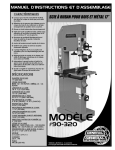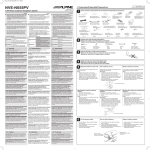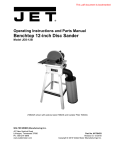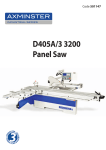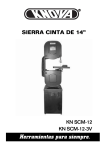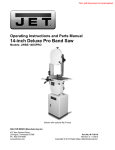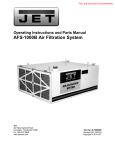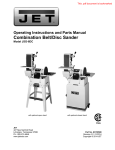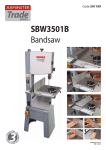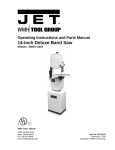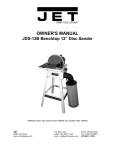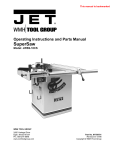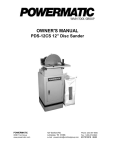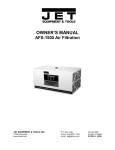Download General International 90-320 M1 Use and Care Manual
Transcript
SETUP & OPERATION MANUAL FEATURES Designed for excellent results, for both wood and metal cutting applications. 17” WOOD / METAL BANDSAW Select between metal & wood cutting speed ranges with a simple belt position change. Dynamically balanced cast-iron wheels. Solid, high quality, precision-machined, ribbed cast-iron table with 5° left and 45° right tilting action. New and improved! Now includes upgraded 90-075B deluxe Excalibur rip fence system. Quick release blade tension lever. Dual/opposing blade guide bearing system. 2 built-in 4" diameter dust chutes for better dust collection. Quick easy adjust variable speed control and digital display for blade speed in FEET/MIN. Large paddle style stop switch with lockout safety pin and lock-out switch with key for main power. Miter gauge, laser line marker and worklight included. SPECIFICATIONS WHEEL SIZE 17” (430 MM) WHEEL SPEED WOOD: 122 - 810 RPM / METAL: 23 - 146 RPM BLADE WIDTH 1⁄8” TO 1” (3 TO 25.4 MM) BLADE LENGTH 131 1⁄2” (3340 MM) TABLE SIZE 23 1⁄2” X 17” (600 X 430 MM) TABLE TILT 0° TO 45° (RIGHT) / 0° TO 5° (LEFT) TABLE HEIGHT 39 3⁄4” (1010 MM) MAXIMUM DEPTH OF CUT 11 1⁄2” (295 MM) MAXIMUM WIDTH OF CUT 16 1⁄4” (410 MM) MAXIMUM CUTTING (RIP FENCE) 14 5⁄8” (370 MM) DUST PORT (2) 4” (102 MM) BLADE SPEED WOOD 540 - 3600 FPM (165 - 1100 MPM) METAL 100 - 650 FPM (30 - 200 MPM) BASE DIMENSIONS (L X W) 29 1⁄2” X 17 3⁄4” (749 X 451 MM) MOTOR 2 HP, 220 V, 3 PH, 7 A) INPUT POWER 220 V, 1 PH WEIGHT 440 LBS (200 KG) MODEL #90-320 VERSION 4_Revision 2 - August 16, 201 © Copyright General® International 08/2012 GENERAL® INTERNATIONAL 8360 Champ-d’Eau, Montreal (Quebec) Canada H1P 1Y3 Telephone (514) 326-1161 • Fax (514) 326-5555 • www.general.ca THANK YOU for choosing this General International model 90-320 - 17” Wood / Metal Bandsaw. This bandsaw has been carefully tested and inspected before shipment and if properly used and maintained, will provide you with years of reliable service. For your safety, as well as to ensure optimum performance and trouble-free operation, and to get the most from your investment, please take the time to read this manual before assembling, installing and operating the unit. ® The manual’s purpose is to familiarize you with the safe operation, basic function, and features of this bandsaw as well as the set-up, maintenance and identification of its parts and components. This manual is not intended as a substitute for formal woodworking instruction, nor to offer the user instruction in the craft of woodworking. If you are not sure about the safety of performing a certain operation or procedure, do not proceed until you can confirm, from knowledgeable and qualified sources, that it is safe to do so. Once you’ve read through these instructions, keep this manual handy for future reference. Disclaimer: The information and specifications in this manual pertain to the unit as it was supplied from the factory at the time of printing. Because we are committed to making constant improvements, General® International reserves the right to make changes to components, parts or features of this unit as deemed necessary, without prior notice and without obligation to install any such changes on previously delivered units. Reasonable care is taken at the factory to ensure that the specifications and information in this manual corresponds with that of the unit with which it was supplied. However, special orders and “after factory” modifications may render some or all information in this manual inapplicable to your machine. Further, as several generations of this model of bandsaw and several versions of this manual may be in circulation, if you own an earlier or later version of this unit, this manual may not depict your machine exactly. If you have any doubts or questions contact your retailer or our support line with the model and serial number of your unit for clarification. GENERAL® & GENERAL® INTERNATIONAL WARRANTY All component parts of General®, General® International and Excalibur by General International ® products are carefully inspected during all stages of production and each unit is thoroughly inspected upon completion of assembly. Limited Lifetime Warranty Because of our commitment to quality and customer satisfaction, General® and General® International agree to repair or replace any part or component which upon examination, proves to be defective in either workmanship or material to the original purchaser for the life of the tool. However, the Limited Lifetime Warranty does not cover any product used for professionnal or commercial production purposes nor for industrial or educational applications. Such cases are covered by our Standard 2-year Limited Warranty only. The Limited Lifetime Warranty is also subject to the “Conditions and Exceptions” as listed below. Standard 2-Year Limited Warranty All products not covered by our lifetime warranty including products used in commercial, industrial and educational applications are warranted for a period of 2 years (24 months) from the date of purchase. General® and General® International agree to repair or replace any part or component which upon examination, proves to be defective in either workmanship or material to the original purchaser during this 2-year warranty period, subject to the “conditions and exceptions” as listed below. To file a Claim To file a claim under our Standard 2-year Limited Warranty or under our Limited Lifetime Warranty, all defective parts, components or machinery must be returned freight or postage prepaid to General® International, or to a nearby distributor, repair center or other location designated by General® International. For further details call our service department at 1-888949-1161 or your local distributor for assistance when filing your claim. Along with the return of the product being claimed for warranty, a copy of the original proof of purchase and a “letter of claim” must be included (a warranty claim form can also be used and can be obtained, upon request, from General® International or an authorized distributor) clearly stating the model and serial number of the unit (if applicable) and including an explanation of the complaint or presumed defect in material or workmanship. CONDITIONS AND EXCEPTIONS: This coverage is extended to the original purchaser only. Prior warranty registration is not required but documented proof of purchase i.e. a copy of original sales invoice or receipt showing the date and location of the purchase as well as the purchase price paid, must be provided at the time of claim. Warranty does not include failures, breakage or defects deemed after inspection by General® or General® International to have been directly or indirectly caused by or resulting from; improper use, or lack of or improper maintenance, misuse or abuse, negligence, accidents, damage in handling or transport, or normal wear and tear of any generally considered consumable parts or components. Repairs made without the written consent of General® Internationallwill void all warranty. TABLE OF CONTENTS Rules for safe operation . . . . . . . . . . . . . .5-6 Electrical requirements . . . . . . . . . . . . . . .7 Grounding instructions . . . . . . . . . . . . . . . . . . . . . . .7 Circuit capacity . . . . . . . . . . . . . . . . . . . . . . . . . . . . .7 Extension cords . . . . . . . . . . . . . . . . . . . . . . . . . . . . .7 Blade speed control . . . . . . . . . . . . . . . . . . . . . . . .22 Changing blade speed range - switching from wood to metal cutting . . . . . . . . . . . . . . . . . . . . . .43 Operating instructions . . . . . . . . . . . . .25-26 Lifting and handling the machine . . . . . . . .9 Connecting to a dust collector . . . . . . . . . . . . . . .25 Checklist before starting . . . . . . . . . . . . . . . . . . . . .25 Operations step-by-step . . . . . . . . . . . . . . . . . . . . .25 Using the rip fence . . . . . . . . . . . . . . . . . . . . . . . . .26 Using the miter gauge . . . . . . . . . . . . . . . . . . . . . .26 Cutting curves . . . . . . . . . . . . . . . . . . . . . . . . . . . . .26 Cutting circles . . . . . . . . . . . . . . . . . . . . . . . . . . . . .26 Unpacking . . . . . . . . . . . . . . . . . . . . . . . .10 Periodic Maintenance . . . . . . . . . . . . . . . .27 List of contents . . . . . . . . . . . . . . . . . . . . . . . . . . . . .10 Additional requirements for set up . . . . . . . . . . . .10 Required Maintenance . . . . . . . . . . . . .27-30 Identification of main parts and components . . . . . . . . . . . . . . . . . . . .8 Basic Functions . . . . . . . . . . . . . . . . . . . . .9 Placement within the shop / Establishing a safety zone . . . . . . . . . . . . .11 Clean up . . . . . . . . . . . . . . . . . . . . . . . . .11 Assembly instructions . . . . . . . . . . . . .12-15 Install the table . . . . . . . . . . . . . . . . . . . . . . . . . . . . .12 Install and adjust the 90º table sstop bolt . . . . . .12 Install the blade guard height adjustment handwheel . . . . . . . . . . . . . . . . . . . . . . . . . . . . . . . .13 Installing the laser line marker . . . . . . . . . . . . . . . .14 Install the fence assembly . . . . . . . . . . . . . . . . . . .15 Basic adjustments & controls . . . . . . . .15-17 On/Off switch & safety pin . . . . . . . . . . . . . . . . . . .15 Lock-out power switch . . . . . . . . . . . . . . . . . . . . . .15 Connecting to a power source . . . . . . . . . . . . . . .16 Tilting the table . . . . . . . . . . . . . . . . . . . . . . . . . . . . .16 Adjusting the blade guard for depth of cut . . . .16 Worklight . . . . . . . . . . . . . . . . . . . . . . . . . . . . . . . . . .17 Recommended adjustments . . . . . . . . .17-24 Removing/Installing the blade . . . . . . . . . . . . . . .17 Blade clearance . . . . . . . . . . . . . . . . . . . . . . . . .17-18 Blade selection . . . . . . . . . . . . . . . . . . . . . . . . . . . .19 Adjusting blade tension . . . . . . . . . . . . . . . . . . . . .20 Blade tracking adjustments . . . . . . . . . . . . . . . . . .21 Adjusting the upper/lower blade guides and thrust bearings . . . . . . . . . . . . . . . . . . . . . . . . . .22-23 Lubrication . . . . . . . . . . . . . . . . . . . . . . . . . . . . . . . .27 Replacing the bandsaw blade . . . . . . . . . . . . . . .27 Replacing the upper and lower blade guides and thrust bearings . . . . . . . . . . . . . . . . . . . . . . . . .28 Replacing the wheel tire . . . . . . . . . . . . . . . . . . . .29 Adjusting/replacing the wheel/blade brushes . .29 Recommended optional accessories . . . . .30 Parts list & diagrams . . . . . . . . . . . . . .32-42 Wiring Diagram . . . . . . . . . . . . . . . . . . . .43 RULES FOR SAFE OPERATION To help ensure safe operation, please take a moment to learn the machine’s applications and limitations, as well as potential hazards. General® International disclaims any real or implied warranty and holds itself harmless for any injury that may result from improper use of its equipment. 1. For your own safety read the instruction manual before operating this band saw. 14. Do not remove jammed cutoff pieces until blade has stopped. 2. This tool is for indoor use only. Do not expose to rain or use in wet or damp locations. 15. Adjust and position upper and lower blade guides before starting to cut. Upper blade guide should be adjusted to approximately 1/8” above the material to be cut. 3. Do not operate this bandsaw when tired, distracted, or under the effects of drugs, alcohol or any medication that impairs reflexes or alertness. 4. The working area should be well lit, clean and free of debris. 5. Keep children and visitors at a safe distance when the bandsaw is in operation; do not permit them to operate the bandsaw. 6. Use right tool. Don't force tool or attachment to do a job for which it was not designed. 7. Childproof and tamper proof your shop and all machinery with locks, master electrical switches and switch keys, to prevent unauthorized or unsupervised use. 8. Stay alert! Give your work your undivided attention. Even a momentary distraction can lead to serious injury. 9. Fine particulate dust is a carcinogen that can be hazardous to health. Work in a well-ventilated area and whenever possible use a dust collector. Wear face, eye, ear, respiratory and body protection devices. 10. Always use safety glasses. Also use face protection or dust mask if cutting operation is dusty. Everyday eyeglasses only have impact resistant lenses, they are NOT safety glasses. 16. Adjust blade tension and tracking before starting to cut. 17. Saw teeth must point down toward the table. 18. Be sure that the blade has gained full operating speed before starting to cut. 19. Always use a clean, properly sharpened blade. Dirty or dull blades are unsafe and can lead to accidents. 20. Use suitable work piece support if the work piece does not have a flat surface. 21. Hold material firmly against the table. 19. Do not work on long stock without adequate support on the out feed end of the table. 20. If using a power feeder, stop the feeder before stopping the bandsaw. 21. Secure work. Use clamps or a vise to hold work when practical. It's safer than using your hand and it frees both hands to operate tool. 22. Do not push or force stock into the blade. The bandsaw will perform better and more safely when working at the rate for which it was designed. 23. Avoid working from awkward or off balance positions. Do not overreach and keep both feet on floor. 11. Do not wear loose clothing, gloves, bracelets, necklaces or other jewelry while the bandsaw is in operation. Wear protective hair covering to contain long hair and wear non-slip footwear. 24. Keep guards in place and in working order. If a guard must be removed for maintenance or cleaning be sure it is properly re-attached before using the tool again. 12. Be sure that adjusting wrenches, tools, drinks and other clutter are removed from the machine and/or the table surface before operating. 25. Maintain proper adjustment of blade tension, blade guides, and thrust bearings. 13. Keep hands well away from blades and all moving parts. Use a brush, not hands, to clear away chips and dust. 26. Always disconnect the tool from the power source before servicing or changing accessories such as blades, or before performing any maintenance or cleaning, or if the machine will be left unattended. 5 RULES FOR SAFE OPERATION (CONT’D) To help ensure safe operation, please take a moment to learn the machine’s applications and limitations, as well as potential hazards. General® International disclaims any real or implied warranty and holds itself harmless for any injury that may result from improper use of its equipment. 27. Make sure that the switch is in the “OFF” position before plugging in the power cord. 28 Never leave the machine unattended while it is running or with the power on. Don't leave tool until it comes to a complete stop 29. Use of parts and accessories NOT recommended by GENERAL® INTERNATIONAL may result in equipment malfunction or risk of injury. 30. Never stand on machinery. Serious injury could result if the tool is tipped over or if the cutting tool is unintentionally contacted. 31. Make sure the tool is properly grounded. If equipped with a 3-prong plug it should be used with a three-pole receptacle. Never remove the third prong. 32. Do not use this bandsaw for other than its intended use. If used for other purposes, GENERAL® INTERNATIONAL disclaims any real implied warranty and holds itself harmless for any injury, which may result from that use. 6 33. Regularly inspect the machine for signs of damage or wear. Before further use of the tool, a guard or other part that is damaged should be carefully checked to determine that it will operate properly and perform its intended function - check for alignment of moving parts, binding of moving parts, breakage of parts, mounting, and any other conditions that may affect its operation. 34. Direction of feed. Feed work into a blade or cutter against the direction of rotation of the blade or cutter only. 35. The installer shall follow local regulations and National Electrical Code, ANSI/NFPA 70 installation requirements. 36. This tool should be connected to a grounded metal permanent wiring system; or to a system having an equipment-grounding conductor. ELECTRICAL REQUIREMENTS BEFORE CONNECTING THE MACHINE TO THE POWER SOURCE, VERIFY THAT THE VOLTAGE OF YOUR POWER SUPPLY CORRESPONDS WITH THE VOLTAGE SPECIFIED ON THE MOTOR I.D. NAMEPLATE. A POWER SOURCE WITH GREATER VOLTAGE THAN NEEDED CAN RESULT IN SERIOUS INJURY TO THE USER AS WELL AS DAMAGE TO THE MACHINE. IF IN DOUBT, CONTACT A QUALIFIED ELECTRICIAN BEFORE CONNECTING TO THE POWER SOURCE. THIS TOOL IS FOR INDOOR USE ONLY. DO NOT EXPOSE TO RAIN OR USE IN WET OR DAMP LOCATIONS. EXTENSION CORDS The use of an extension cord is not generally recommended for 220V equipment. If you find it necessary, use only 3-wire extension cords that have 3-prong grounding plug and a matching 3-pole receptacle that accepts the tool’s plug. Repair or replace a damaged extension cord or plug immediately. GROUNDING INSTRUCTIONS In the event of an electrical malfunction or short circuit, grounding reduces the risk of electric shock to the operator. The motor of this machine is wired for 220V single phase operation and is equipped with a 3-conductor cord and a 3-prong grounded plug to fit a matching grounding type receptacle . DO NOT MODIFY THE PLUG PROVIDED ! If it will not fit your receptacle, have the proper receptacle installed by a qualified electrician. CHECK with a qualified electrician or service person if you do not completely understand these grounding instructions, or if you are not sure the tool is properly grounded. If you find it necessary to use an extension cord with your machine make sure the cord rating is suitable for the amperage listed on the motor I.D. plate. An undersized cord will cause a drop in line voltage resulting in loss of power and overheating. The accompanying chart shows the correct size extension cord to be used based on cord length and motor I.D. plate amp rating. If in doubt, use the next heavier gauge. The smaller the number, the heavier the gauge. TABLE - MINIMUM GAUGE FOR CORD AMPERE RATING <5 6 TO 10 10 TO 12 12 TO 16 TOTAL LENGTH OF CORD IN FEET 220 VOLTS 50 FEET 100 FEET 200 FEET 300 FEET -------> -------> -------> -------> 18 AWG 16 16 14 18 16 14 12 16 16 14 12 14 12 * NR * NR * NR = Not Recommended CIRCUIT CAPACITY Make sure that the wires in your circuit are capable of handling the amperage draw from your machine, as well as any other machines that could be operating on the same circuit. If you are unsure, consult a qualified electrician. If the circuit breaker trips or the fuse blows regularly, your machine may be operating on a circuit that is close to its amperage draw capacity. However, if an unusual amperage draw does not exist and a power failure still occurs, contact a qualified technician or our service department. 7 17” WOOD / METAL BANDSAW 90-320 IDENTIFICATION OF MAIN PARTS AND COMPONENTS FRONT VIEW HOISTING EYEBOLT LASER LINE MARKER BLADE TENSION WINDOW DIGITAL SPEED DISPLAY VARIABLE SPEED CONTROL KNOB ON/OFF SWITCH WITH SAFETY KEY RIP FENCE SYSTEM MITER GAUGE BLADE GUARD WORKLIGHT BLADE GUARD HEIGHT ADJUSTMENT HAND WHEEL BLADE TRACKING WINDOW 8 REAR VIEW BLADE TENSION QUICK RELEASE LEVER BLADE GUARD LOCK KNOB BLADE TRACKING ADJUSTMENT LEVER BLADE TRACKING ADJUSTMENT KNOB BLADE TENSION ADJUSTMENT HAND WHEEL TABLE TILT ADJUSTMENT LOCK LEVER TABLE TILT ADJUSTMENT KNOB DUST CHUTE LOWER WHEEL TILT ADJUSTMENT SCREWS BELT TENSION ADJUSTMENT HAND WHEEL BELT TENSION ADJUSTMENT MECHANISM MOTOR BASIC FUNCTIONS This model 90-320 electronic variable speed 17” bandsaw is designed to allow the user to adjust the speed of the blade to suit different wood or metal cutting needs. This unit includes all of the basic functions and features found on similar size bandsaws. Featuring a front mounted digital blade speed display (in feet per minute) the unit is equipped with two speed ranges. By simply changing the positioning of the drive belt from one set of pulleys to the other the user can select a speed range, Metal (100-650 FPM) or Wood (540-3600 FPM), depending on the cutting application. The speed control adjustment knob allows the user to dial in the required speed within each speed range. The 90-320 is designed to accommodate both wood and metal cutting blades from 1/8” – 1” in width and is supplied with one 1/2” general purpose wood cutting blade (factory installed) and one 1/2” general purpose metal cutting blade. Ideal blade length for the model 90-320 is 131 1/2” (3340mm). Note: Generally speaking, because the upper wheel height is somewhat adjustable (to allow for blade tensioning), a blade length variation of plus or minus 1/2” from the “ideal blade length” can be accommodated. Maximum inboard width of cut (space between the blade and the body of the saw) is 16 1/4”. For cutting thicker stock or resawing, the maximum depth of cut (or max. workpiece height) is 11 1/2”. An adjustable rip fence is supplied to serve as a straightedge to guide the workpiece for longer rip cuts. The fence can easily be removed and set aside when not required, for example when making curved cuts. LIFTING AND HANDLING THE MACHINE This model 90-320 17” Wood/Metal Bandsaw is very heavy. Do not over-exert. A hoist or forklift with chains will be needed for the following step. To limit the risk of serious injury or damage to the machine, any equipment used to lift or move this machine (hoist or forklift) should have a rated capacity in excess 440lbs (200kg) To limit the potential for damage in transport, this bandsaw is shipped from the factory bolted to its crate in the vertical position. With a forklift or hydraulic pallet jack, move the entire crate as close to the final installation location as possible, and then uncrate the saw and remove the screws that secure it to the crate . A hoisting eyebolt is factory installed on the top of the saw frame to facilitate lifting and setting the saw down. Make sure to use an appropriate capacity hoist or forklift with chains properly secured to the hoisting eyebolt and lift the saw from the crate and carefully set it down in the desired location. 9 UNPACKING Carefully unpack and remove the unit and its components from its shipping container and check for missing or damaged items as per the list of contents below. SAW, TABLE & OTHER COMPONENTS* NOTE: Please report any damaged or missing items to your GENERAL® INTERNATIONAL distributor immediately. LIST OF CONTENTS QTY BOX 1 - EXCALIBUR RIP FENCE Note: Deluxe Excalibur Universal rip fence system is packed separately. Refer to the manual supplied in the box with Excalibur rip fence for complete list of contents. SAW, TABLE & OTHER COMPONENTS* The other components are stored inside the lower cabinet to prevent damage in shipping. 17” WOOD / METAL CUTTING BANDSAW . . . . . . . . .1 ( WITH 1/2” X 6 TPI WOOD CUTTING BLADE INSTALLED ON) BANDSAW TABLE . . . . . . . . . . . . . . . . . . . . . . . . . . . . .1 V-BELT (A-27) . . . . . . . . . . . . . . . . . . . . . . . . . . . . . . . .1 1/2” X 10 TPI METAL CUTTING BLADE . . . . . . . . . . . . .1 MITER GAUGE . . . . . . . . . . . . . . . . . . . . . . . . . . . . . . .1 BLADE GUARD HEIGHT ADJUSTMENT HAND WHEEL .1 LOCK-OUT SWICH KEY . . . . . . . . . . . . . . . . . . . . . . . . .2 SAFETY LOCKING PIN . . . . . . . . . . . . . . . . . . . . . . . . .1 HEX HEAD BOLT . . . . . . . . . . . . . . . . . . . . . . . . . . . . . .4 FLAT WASHER . . . . . . . . . . . . . . . . . . . . . . . . . . . . . . . .4 LOCK WASHER . . . . . . . . . . . . . . . . . . . . . . . . . . . . . . .4 TABLE STOP BOLT . . . . . . . . . . . . . . . . . . . . . . . . . . . . .1 STOP BOLT JAM NUT . . . . . . . . . . . . . . . . . . . . . . . . . .1 8 MM ALLEN KEY . . . . . . . . . . . . . . . . . . . . . . . . . . . . .1 5 MM ALLEN KEY . . . . . . . . . . . . . . . . . . . . . . . . . . . . .1 10 - 13 MM OPEN END WRENCH . . . . . . . . . . . . . . . .1 BOX 2 - LASER LINE MARKER (INSIDE LOWER CABINET) LASER LINE MARKER . . . . . . . . . . . . . . . . . . . . . . . . . .1 MOUNTING BRACKET . . . . . . . . . . . . . . . . . . . . . . . . .1 BUTTON HEAD BOLT (SHORT) . . . . . . . . . . . . . . . . . . .1 BUTTON HEAD BOLT (LONG) . . . . . . . . . . . . . . . . . . . .1 SOCKET SCREW . . . . . . . . . . . . . . . . . . . . . . . . . . . . . .1 FLANGED NUT . . . . . . . . . . . . . . . . . . . . . . . . . . . . . . .1 3 MM ALLEN KEY . . . . . . . . . . . . . . . . . . . . . . . . . . . . .1 ADDITIONAL REQUIREMENTS FOR SET UP • 6 mm allen key • Combination square 10 LASER LINE MARKER PLACEMENT WITHIN THE SHOP / ESTABLISHING A SAFETY ZONE PLACEMENT WITHIN THE SHOP This machine should be installed and operated only on a solid, flat and stable floor that is able to support the weight of the bandsaw 440 lbs (200 kg) and the operator. Using the dimensions shown as a guideline, plan for placement within your shop that will allow the operator to work unencumbered and unobstructed by foot traffic (either passing shop visitors or other shop workers) or other tools or machinery. 95” ESTABLISHING A SAFETY ZONE For shops with frequent visitors or multiple operators, it is advisable to establish a Safety Zone around shop machi-nery. A clearly defined “no-go” zone on the floor around each machine can help avoid accidents that could cause injury to either the operator or the shop visitor. It is advi-sable to take a few moments to either paint (using non-slip paint) or using tape, define on the floor the limits or perimeter of each machines safety zone. Take steps to ensure that all operators and shop visitors are aware that these areas are off limits whenever a machine is running for everyone but the individual operating the unit. 32” 41” CLEAN UP The protective coating on the saw table prevents rust from forming during shipping and storage. Remove it by rubbing with a rag dipped in kerosene, mineral spirits or paint thinner. (Dispose of potentially flammable solvent-soaked rags according to manufacturer’s safety recommendations.) A putty knife, held flat to avoid scratching the surface, may also be used to scrape off the coating followed by clean-up with solvent. Avoid rubbing the saw’s painted surfaces, as many solvent-based products will remo-ve paint. To prevent rust, apply a light coating of paste wax or use regular applications of any after-market surface protectant or rust inhibitor. Tip: With a screw driver, push a solvent-saturated rag into the T-slot to remove the grease. 11 ASSEMBLY INSTRUCTIONS For your convenience this bandsaw is shipped from the factory partially assembled and requires only minimal assembly and set up before being put into service. Serious personal injury could occur if you connect the machine to the power source before you have completed the installation and assembly steps. DO NOT connect the machine to the power source until instructed to do so. INSTALL THE TABLE 1. To limit the risk of damage to the saw blade or frame, remove the blade. Follow the instructions in section “Blade Clearance” on page 17, then remove the blade as instructed in section “Removing/Installing the blade” on page 18. This bandsaw table is heavy. Do not over-exert. The help of an assistant will be needed for the following step. TABLE UNDERSIDE VIEW 2. Gently lower the table onto the table tilt trunnion , with the table slots oriented as shown . 4. Re-install the blade as instructed on page 19. 3. Using the supplied 10 - 13 open end wrench, secure the table to the trunnions with the 4 hex head bolts, lock washers and flat washers , in the assembly order shown in . 2. Thread the jam nut on the stop bolt then thread the bolt in the theaded hole located on the saw cabinet , 7 or 8 turns. INSTALL AND ADJUST THE 90º TABLE STOP BOLT 1. 12 Loosen the locking lever then turn the adjustment knob to tilt the table upwards as shown. TABLE UNDERSIDE VIEW 3. Lower the table until it sits on top of the bolt. 4. Place a combination square flat on the table with the heel of the square flat against the saw blade. 4. If the pointer needs to be adjusted, loosen the screw on the pointer of the front trunnion and adjust the pointer to the 0 point on the scale. Then re-tighten the screw to secure the pointer in place. CLOSE UP 3. Level the table until it is exactly 90° to the saw blade then tighten the jam nut against the saw cabinet . Note: With the table set to 90º and the stop bolt at the correct height, make sure the table tilt angle indicator pointer is set to read 0º. You will now be able to accurately return the table to the 90º position automatically without further adjustments and scale reading for any angle other than 0° will also be accurate. INSTALL THE BLADE GUARD HEIGHT ADJUSTMENT HANDWHEEL CLOSE UP 1. Install the handwheel on the shaft , located on the right side of the upper wheel cover, by aligning the flat surface of the shaft with the Allen bolt already mounted on the handwheel . 2. Tighten with the supplied 5 mm Allen key to secure the handwheel on the shaft. 13 INSTALL THE LASER LINE MARKER The laser line marker will allow you to easily mark a straight cut line on your workpiece. 1. Thread the shorter button head bolt side of the upper cabinet. from the in- 3. Loosely screw the longer button head bolt . 2. Attach the mounting bracket to the front of the saw using the socket screw through the door and the flange nut on the inside of the door. 4. Unscrew and remove the cap and install two AAA batteries (not included), then fit the laser line marker into the the hole in the mounting bracket . OFF 5. Using the supplied 3 mm Allen key, tighten the longer button head screw , to secure the laser line marker into it’s mounting bracket. ON Align the laser beam on the blade as follows: 1. Press on the ON/OFF switch button (located on top of the laser line marker) to turn the laser ON. 2. Loosen the socket screw and move the laser left or right along the elongated hole and/or loosen the button head bolt and move the laser up or down until the beam is aligned with the blade . 3. Press on the ON/OFF switch button once again to to turn the laser OFF. 14 INSTALL THE FENCE ASSEMBLY This model 90-320 M1 is equipped with an Excalibur T-fence and guide rail system. Follow all assembly and adjustment instructions in the 90-075B manual supplied in the box with the Excalibur Universal Bandsaw Rip Fence System. BASIC ADJUSTMENTS AND CONTROLS ON/OFF SWITCH & SAFETY PIN LOCK-OUT POWER SWITCH OFF The ON/OFF switch assembly is equipped with a lockout safety pin . When the pin is installed through the green “on” button , the machine cannot be started. To start the machine, lift the red stop switch panel and remove the lock-out pin. Lower the stop panel and push the green “ON” button. Wait for the saw blade to reach full speed before cutting. To stop the machine, push on the RED “STOP” panel and wait for the blade to come to a complete stop. When you have finished using the machine be sure to re-install the lock-out pin and unplug the machine from the power source. ON This model 90-320 is also equiped with a lock-out switch . When this switch is locked (OFF position), the machine cannot be started by pressing on the green “on” button, even if the lock-out safety pin has been removed. To start the machine, set the power lock-out switch to ON position using the supplied key , then lift the red stop switch panel and remove the lock-out pin. Lower the stop panel and push the green “ON” button. Set the lock-out switch to the OFF position and store the keys in a safe place, out of the reach of children, whenever the bandsaw is not in use. 15 CONNECTING TO A POWER SOURCE To avoid risk of shock or fire do not operate the unit with a damaged power cord or plug. Replace damaged cord or plug immediately. 1. Uncoil the power cord and plug it into an appropriate outlet (refer back to section “Electrical Requirements" and make sure all requirements and grounding instructions are followed). To avoid unexpected or unintentional start-up, make sure that both of the power switches are in the the OFF position before connecting to a power source. TILTING THE TABLE The table can be tilted to any angle from 0° to 45° to the right and 0° to 5° to the left to allow for any type of bevel (or angle) cutting. Refer to the table tilt angle indicator under the bandsaw table to set the angle of the table to the desired position. TABLE UNDERSIDE VIEW Never adjust the table angle while the bandsaw is running. Turn off power first. 1. Loosen the locking lever 2. Turn the knob to tilt the table until it is at the desired angle. (Refer to the angle indicator .) 3. Tighten the locking lever to lock the table in position. . ADJUSTING THE BLADE GUARD FOR DEPTH OF CUT The blade guard can be moved up or down to accommodate the height of the work to be cut . To prevent the blade (which is flexible and which would not otherwise be supported) from slipping out of position during cutting, and to reduce risks of injuries, a minimum amount of blade should be exposed. The blade guard should be set 1/8” - 1/4” above the workpiece to prevent the blade from flexing out of position or offline during cutting. 1/8” - 1/4” Adjust the height of the blade guard to suit the thickness of the workpiece as follows: CLOSE UP 1. Make sure the bandsaw is turned off and the power cord is disconnected from the power source. 2. Loosen the lock knob . RAISE 3. Move the blade guide assembly up or down by turning the handwheel . Then re-tighten the lock knob . Note: The depth gauge on the front of the blade guard can be used as a reference but it is not intended for high precision measurements. 16 LOWER WORKLIGHT The goose neck style worklight on this model 90-320 provides extra lighting for added convenience. It can be repositionned for optimal lighting of the work surface. Note: Uses a standard 40 Watt (maximum) 120 volt appliance bulb - Not Included. To reduce the risk of fire, use 40 Watt (maximum) 120 volt appliance bulb. Do not use standard household bulbs. - Turn the ON/OFF switch once to turn the worklight ON: - Turn it once again to turn the worklight OFF: RECOMMENDED ADJUSTMENTS REMOVING/INSTALLING THE BLADE The 90-320 is designed to accommodate both wood and metal cutting blades from 1/8” – 1” in width and is supplied with one 1/2” general purpose wood cutting blade (factory installed) and one 1/2” general purpose metal cutting blade. BLADE CLEARANCE Note: When performing blade installation, removal, tensioning or tracking, maximum clearance between the blade and both upper and lower bearing assemblies is required to minimize friction, which would be damaging to the blade. UPPER ASSEMBLY - RIGHT SIDE VIEW Proceed as follows: Move the upper assembly back: 1. Loosen the Allen bolt key. with the supplied 5 mm Allen 2. Then pull on the assembly shaft going back as far as possible for maximum blade clearance. 3. Tighten the Allen bolt to lock the assembly in place. TABLE UNDERSIDE - REAR VIEW Move the lower thrust bearing away from the blade: 1. Loosen the Allen bolt key. with the supplied 5 mm Allen 2. Turn the knob until the thrust bearing sible for maximum blade clearance. 3. Tighten the Allen bolt to lock the thrust bearing in place. is as far as pos- TABLE UNDERSIDE - FRONT VIEW Move the lower blade guides away from the blade: 1. Loosen the two Allen bolts key. with the supplied 5 mm Allen 2. Turn the adjustment knobs outward as needed obtain maximum blade clearance. 3. Tighten the two Allen bolts to lock the blade guides in position. , so as to 17 To remove a blade: Before replacing or adjusting the blade, make sure that both of the power switches are in the “OFF” position and that the power cord is unplugged. Blade teeth are sharp. Use care when handling a saw blade. Note: For blade tension quick release, pull the tension lever up as shown in . For quick blade tensioning, push the tension lever down, as shown in . To avoid damaging the tensioning mechanism never force the tension lever beyond “Tight” and “Loose” positions as shown in . LOOSE 1. Put the tension lever in the loose position as shown in to loosen the tension on the blade. It may be necessary to also turn the tension adjust ment hand wheel counter-clockwise for the blade to be loose enough to remove easily. TIGHT DO NOT 2. Remove the red insert from the center of the table and the table alignment pin from the table slot. 4. With the blade perpendicular to the wheels, feed the blade through the table slot, , to free it from the saw. Note: You may want to use a thick shop towel to handle the loose blade or wear a pair of heavy duty work gloves. 3. Open the top and bottom wheel cover doors and , carefully pull the blade from the left side slot blade guard 5. , and from the wheels. Carefully hang the blade on a hook in a safe, dry place in your workshop if it will be re-used, or dispose of it safely if it is worn or damaged. Do not attempt to coil up the blade as it was when you first purchased it as it has a tendancy to pop open unexpectedly and could cause injury. 18 BLADE SELECTION There are a variety of different types of bandsaw blades on the market to suit various cutting applications. Your results may vary based on usage, experience and personal preference. Standard size - 131 1/2” (3340 mm) - replacement blades for either wood cutting or metal cutting applications can be found through your local tool dealer or bandsaw blade specialist. Note: The use of any size outside of the saw’s specified length or width range is not recommended and can lead to serious injury and/or damage to the machine. Generally speaking, because the upper wheel height is somewhat adjustable (to allow for blade tensioning), a blade length variation of plus or minus 1/2” from the “ideal blade length” can be accommodated. Some general guidelines to consider when choosing bandsaw blades: • Wider blades with fewer teeth per inch are best suited to cutting straight lines, re-sawing and for sweeping curves, but will not turn tight radius curves. They will cut quickly and aggressively but do have a tendency to bind (or get stuck in the cut) if turned too sharply. • Narrower, thinner blades with more teeth per inch will cut more slowly but can turn much tighter corners for cutting more intricate work. Common causes of blade breakage: • • • • • • • • Poor guide bearing alignment and adjustment. Forcing or twisting a wide blade around a short radius. Feeding the workpiece too quickly. Dull teeth. Too much blade tension. Setting blade guard assembly too high above the workpiece. Lumpy or improperly finished braze or weld on the blade. Continuous running of blade when not cutting. To install a blade: 1. Turn off the bandsaw and unplug the power cord. Note: You may want to use a thick shop towel to handle the loose blade or wear a pair of heavy duty work gloves for the following steps. Beware of the blade popping open. 2. If you are installing a new blade, carefully remove the blade from its package. Hold it firmly with one hand as you remove the twist ties. Slowly separate the coils of the blade until it unravels into one hoop. Note: Step 3 may be unnecessary if you’ve just removed a blade. (If needed, refer back to the previous page.) 3. Remove the table alignment pin from the table slot and the red insert from the center of the table. 4. With the blade perpendicular to the wheels, guide it through the table slot, then rotate the side of the blade nearest you back toward the left side of the wheels. 5. Feed the blade into the left side slot, blade guard and around the wheels. Make sure the blade teeth point forward and down . Proper installation Improper installation With the blade properly installed, proceed to blade tension adjustments and blade tracking adjustments, as per instructions on the next few pages. 19 ADJUSTING BLADE TENSION Determining ideal blade tension is somewhat subjective. It is learned through practice and experience and is somewhat dependant on personal preference and individual work habits. A properly tensioned blade is critical to obtaining maximum performance from any bandsaw. A properly tensioned blade will last longer and be much less likely to break prematurely. If the blade tension is too loose you will notice that the blade will have a tendency to drift or slip off-line when cutting and you will have more difficulty controlling your cuts. A blade that is tensioned too tightly will break prematurely and will be difficult to work with when making tighter radius cuts. The following information can be used as a guideline or starting point to assist you in determining ideal blade tension for your needs: • When working with wider blades, re-sawing taller stock, making straight cuts or wide sweeping curves tighter blade tensions will provide better results. • When working with narrower blades, sawing shorter stock and making tighter curved cuts are best performed using less tension To adjust blade tension proceed as follows: Before making blade tension adjustments, make sure that both of the power switches are in the “OFF” position and that the power cord is unplugged. 1. 3. Put the tension lever in the tight position as shown for quick blade tensionning. If needed, adjust the blade tensioning by turning the blade tension hand wheel : - Clockwise to tighten - Counter-clockwise to loosen the blade tension. 4. 2. With the saw turned off, press against the side of the blade to test the tautness of the blade. For ideal results with most blade widths and cutting applications the blade should flex in no more than 1/4" to 3/8". Note: the blade tension indicator scale can be used as a reference – the longer the line on the scale the tighter the tension on the blade. Take note of ideal setting with various blade widths for reference the next time that blade is used or when a similar type of cut is to be performed. Make a test cut on a sample piece of wood and if needed re-adjust the blade tension. Note: To prolong the life of the blade whenever the band saw is not in use for prolonged periods (more than 24 hours), release the blade tension lever to remove tension from the blade, Over time, maintaining tension on a blade that is not in use will cause the blade to deform, by taking the shape of the wheels at both extremities. This can weaken the blade and cause premature breakage. 20 BLADE TRACKING ADJUSTMENTS Ideally, the blade should stay relatively centered upper and lower wheels. 3 MM - 1/8" on both the Due to natural variations in castings, blade thickness or density and tire wear, absolute perfect centering alignment is rarely attainable. A slight misalignment of the blade on the wheels is inevitable and as long as it is kept to a minimum (following the steps listed below) will not hinder the performance of the saw. This misalignment is controlled and kept to a minimum primarily by adjusting the tilt angle of the upper wheel. When adjusting blade tracking to center the blade on the wheels and assuming that perfect centering is not attainable, it is preferable to have the blade slightly off-center towards the front of the wheels rather than towards the rear because the teeth on most band saw blades have alternating hook (one inner, one outer) – therefore if the blade is centered too far back on the wheel (or if the blade tension is too tight), inner hooked teeth will dig into the wheel tire and cause premature wear of the tire. Nonetheless, to avoid having the blade come off of the wheels on it’s own during operation, the front edge of the blades teeth should never be any closer than 3 mm (1/8”) from the front edge of the wheel . BLADE CLEARANCE Note: As previously stated, when performing blade installation, removal, tensionning or tracking, maximum clearance between the blade and both upper and lower bearing assemblies is required to minimize friction, which would be damaging to the blade. Refer back to page 17 and follow the instructions for “BLADE CLEARANCE” before performing blade tracking adjustments. 1. Open the upper wheel cover door then rotate the wheel slowly forward by hand and check (through the window of the upper wheel ) the position of the blade on the wheel. The blade should remain as centered as possible on the wheel as it turns . 2. If the blade tracking must be adjusted, loosen the locking lever on the tracking adjustment knob , then turn the knob: - Clockwise if the blade moves toward the front of the wheel. This tilts the top of the wheel to the back and moves the blade toward the center. - Counter-clockwise if the blade moves toward the back edge. This tilts the top of the wheel to the front and moves the blade toward the center. Note: Turn the tracking knob in 1/2 turn increments, re-check and adjust again as needed. 3. With the tracking set, tighten the locking lever to secure the tracking adjustment knob in place. CW if blade moves to FRONT CCW if blade moves to BACK Note: The upper and lower wheels are factory set to allow for easy and optimal blade tracking adjustments using the primary blade tracking adjustment knob, which adjusts the angle of tilt of the upper wheel. In extremely rare cases, if acceptable blade tracking cannot be attained through the primary adjustment it may eventually become necessary to make minor adjustments to the angle of tilt of the lower wheel. The four bolts may be adjusted in or out to tilt the lower wheel up/down or left/right as needed. 21 ADJUSTING THE UPPER / LOWER BLADE GUIDES AND THRUST BEARINGS The blade guides keep the blade from moving from side to side during cutting and must be snug but not touching the blade in order to ensure accurate cuts. The space between each guide and the blade must not exceed 0.02" (the thickness of a sheet of paper). If less space is left, the blade will get stuck or jammed between both guides. Too much friction will cause blade to overheat and break. Also, the guides must remain at least 1/32” behind the blade teeth to prevent damage to the blade. The thrust bearings keeps the blade from moving back and out of position when the work is being fed into the blade and must be very close to the back of the blade to prevent damage to the blade during cutting. Note: Before adjusting the upper and lower blade guides and thrust bearings, make sure the blade is tensioned and tracking properly. Adjust the upper and lower blade guides and thrust bearings after each blade tension and tracking adjustment. To avoid injury, make sure that both of the power switches are in the “OFF” position and that the power cord is unplugged before performing any adjustments on the bandsaw. Adjust the positioning of the upper blade guides and thrust bearing assembly as follows: UPPER ASSEMBLY - RIGHT SIDE VIEW The upper blade guides and thrust bearing are assembled as one unit which can be moved back or forward. To prevent damage to the blade, the blade guides must remain behind the blade teeth during operation. 1. Loosen the Allen bolt 2. Move the upper assembly forward along the shaft , until the blade guides are at least 1/32" behind the blade teeth , (do not protrude past the hollowed part of the teeth of the blade. 3. Tighten the Allen bolt 1/32" with the supplied 5 mm Allen key. to lock the assembly in place. Adjust the positioning of the upper thrust bearing as follows: 1. Loosen the Allen bolt key. 2. Move the shaft in or out , until the thrust bearing barely touches the blade (is 1/64" behind the back of the blade ). 3. Tighten the Allen bolt in position. to lock the thrust bearing Adjust the positioning of the upper and lower blade guides as follows: 1. Loosen the two Allen bolts Allen key. 2. Turn the adjustment knobs inward as needed , to obtain a space of 0.02" (the thickness of a sheet of paper) between both guides and the blade . with the supplied 5 mm Tip: Place a feeler gauge or sheet of paper between each guide and the blade to make sure there is a 0.02" space. 3. Tighten the two Allen bolts to lock the blade guides in position. 4. Repeat steps 1 to 3 with the lower blade guides 22 1/64" with the supplied 5 mm Allen . 0.02" 0.02" Adjust the positioning of the lower blade guide assembly as follows: 1. Loosen the Allen bolt key. 2. Move the lower blade guide assembly forward along the shaft , until the blade guides are at least 1/32" behind the blade teeth , (do not protrude past the hollowed part of the teeth of the blade. 3. Tighten the Allen bolt 1/32" with the supplied 5 mm Allen to lock the assembly in place. Adjust the positioning of the lower thrust bearing as follows: 1. Loosen the Allen bolt key. 2. Turn the knob until the thrust bearing barely touches the blade (is 1/64" behind the back of the blade) . 3. Tighten the Allen bolt in position. 1/64" with the supplied 5 mm Allen to lock the thrust bearing BLADE GUARD REMOVED FOR CLARITY ONLY BLADE SPEED CONTROL The blade speed ranges from 540 to 3600 Feet Per Minute (FPM) for Wood cutting and from 100 to 650 FPM for Metal cutting applications, depending on the positionning of the drive belt on the pulleys. Note: Refer to the reference chart below for speed selection for metal cutting, based on workpiece material . The blade speed control knob is located on the control box, just above the on/off switch, . - Turn the knob clockwise speed. to increase the blade - Turn the knob counter-clockwise blade speed. Decrease speed Increase speed to decrease the The blade speed will be indicated on the digital speed display . METAL CUTTING BLADE AND SPEED REFERENCE CHART WORKPIECE MATERIAL BLADE SPEED IN FEET PER MINUTE (FPM) REMARK STEEL (TOUGH) 100 - 125 10 - 14 TPI Blade / Low feed rate MILD STEEL 150 - 250 5 - 10 TPI Blade / Moderate feed rate CAST-IRON (MEDIUM) 150 - 250 5 - 10 TPI Blade / Moderate feed rate BRONZE 150 - 250 5 - 10 TPI Blade / Moderate feed rate BRASS 300 - 400 5 - 10 TPI Blade / Moderate feed rate ALUMINUM 250 - 350 5 - 10 TPI Blade / Moderate feed rate PLASTIC 700 - 800 5 - 10 TPI Blade / Moderate feed rate *The information in this chart is supplied as a general guideline only. Your results may vary depending on blade material, as well as its quality and sharpness. For best results always follow any speed recommendations supplied with the blades being used. 23 CHANGING BLADE SPEED RANGE – SWITCHING FROM WOOD TO METAL CUTTING To avoid injury, make sure that the switch is in the “OFF” position and that the power cord is unplugged before performing any adjustments on the bandsaw. By simply changing the positioning of the drive belt from one set of pulleys to the other, the user can select a speed range, Metal (100-650 FPM) or Wood (540-3600 FPM), depending on the cutting application. The 90-320 is factory set for Wood cutting applications. The drive belt is positioned to allow a 540-3600 FPM speed range and the blade installed is a wood cutting blade. To switch from wood to metal cutting: 1. Remove the wood cutting blade and install a metal cutting blade, adjust the blade tension and tracking, then adjust the upper and lower blade guides and thrust bearings. Note: When transfering belt A44, take care in doing so not to touch the sensor as this would affect the blade speed display accuracy. 2. Loosen the lock lever that locks the motor pivot, then, using the handle , lift the motor by hand and tighten lever to lock the motor in position. This will loosen the drive belt. 3. Transfer belt A44 (factory installed) from the drive pulley to the inside groove on the idler pulley , then set the motor back to it’s initial position to tighten the belt around the pulleys. Max 1/8” 4. Install the supplied shorter belt (A27) on the outside groove of the drive pulley and outside groove of the idler pulley, . Note: When transfering belt A44 or installing belt A27, take care in doing so not to touch the sensor (step 3) as this would affect the blade speed display accuracy. 5. Loosen the cap screw using the supplied 8 mm Allen key to unlock the belt tensioning mecanism. 6. Use the tension adjustment hand wheel sion the belt. 7. Squeeze the belt with your hand . The belt should move no more than 1/8". If needed, readjust the belt tension. 8. Re-tighten the cap screw sioning mecanism. 24 to ten- to lock the belt ten- OPERATING INSTRUCTIONS CONNECTING TO A DUST COLLECTOR This model 90-320 is equiped with two built-in 4" diameter dust chutes to accommodate connection to a dust collector (not included). Bee sure to use appropriate sized hose and fittings (not included) and check that all connections are sealed tightly to help minimize airborne dust. If you do not already own a dust collection system consider contacting your General® International distributor for information on our complete line of dust collection systems and accessories or visit our Web Site at: www.general.ca. CHECKLIST BEFORE STARTING NOTE: Now that you have completed the five adjustment steps which are an essential part of safe, accurate bandsaw operation, it would be a good idea to make yourself a checklist as follows to ensure that each adjustment to the bandsaw is made in the proper order starting with the general safety precaution: 1. Turn off the bandsaw and unplug the power cord. 2. Adjust blade tension. 3. Adjust blade tracking. 4. Adjust upper blade guides and support bearing. 5. Adjust lower blade guides and support bearing. 6. Select the right speed range depending on the cutting application. These additional safety measures should be be included in your checklist: 7. 8. Make sure all the blade guards are in place. Make sure the bandsaw table and work area in general are clean and free of sawdust and debris. These steps should always be followed when any adjustment is performed, the blade is changed, or periodically as vibration and normal wear and tear on the machine could throw these parts out of alignment. OPERATIONS STEP-BY-STEP To reduce the risk of damage to the bandsaw or the workpiece, as well as a potential for personal injury, after initial set-up as well as before each use, make sure that everything is securely installed and that all fasteners and moving parts on this bandsaw are locked in place before starting the machine. 1. Trace the cutting line on your workpiece with a pencil (for cutting curves) or adjust the laser beam to mark the cutting line (for cutting straight lines). If needed, refer back to section “laser line marker” on page 13. 2. Set the height of the blade guard according to the thickness of your workpiece (see section: “Adjusting the blade guard for depth of cut” on page 16.) 3. If a dust collector is connected to your bandsaw, turn it on. 4. Push on the green “ON” button to start the bandsaw. 5. Align the cutting line on your workpiece with the blade and feed the workpiece into the blade. Tip: The use of a roller stand provides an extra support for more convenience when working with longer workpieces. TO STOP THE MACHINE 1. Push the red “STOP” panel. 2. Turn your dust collector off. 25 USING THE RIP FENCE 1. Set the fence down on the rail either to the left or right of the blade. Note: For short workpieces that fit between the frame of the saw and the blade , position the fence at the left side of the blade. For cutting longer or wider workpieces, position the fence, on the right side of the saw blade. 2. Adjust the positioning of the fence on the rail so that the distance from the inside face of the rip fence to the blade matches the required width of cut. 3. Tighten the locking handle place. to lock the the fence in Make sure to lock the fence in place before starting to cut against the rip fence. USING THE MITER GAUGE Using the miter gauge supplied with your bandsaw allows for easier and safer sawing by providing workpiece support when cutting straight (90°) or angled ends (0° to 30°). The miter gauge rides in the table slot to the right of the blade and can be set to any angle up to 30° to the left or right. It also acts as a feeder for advancing smaller workpieces through the blade with reduced risk of injury to the hands. To use a setting other than 90°, loosen the locking handle by turning it counterclockwise. Rotate the miter head to the required angle , shown on the angle indicator. Then turn the locking handle clockwise to tighten it. CUTTING CURVES • When cutting curves, carefully turn the workpiece so the blade follows without twisting. If the curve is so sharp that you repeatedly back up and cut new kerf, use a narrower blade, or a blade with more set (teeth further apart). When a blade has more set, the workpiece turns easier but the cut is rougher. • When changing a cut, do not withdraw the workpiece from the blade. The blade may get drawn off the wheels. • To change a cut, turn the workpiece and cut your way out through the waste material area. • When cutting long curves, make relief cuts as you go along. CUTTING CIRCLES 1. Adjust the blade guard assembly to 1/8" above the workpiece. MIN. CIRCLE DIAMETER 2. Use both hands while feeding the work into the blade. Hold the workpiece firmly against the table. Use gentle pressure. Do not force the work. Allow the blade to cut. 3. The smallest diameter circle that can be cut is determined by the width of the blade. For example, a 1/4" wide blade will cut a minimum diameter of approximately 1-1/2" . 26 BLADE WIDTH PERIODIC MAINTENANCE Never operate the bandsaw with any damaged part. Replace a damaged part at the first visible signs of damage. 1. Inspect/test the ON/OFF switch before each use. Do not operate the bandsaw with a damaged switch; replace a damaged switch immediately. 2. Periodically inspect the power cord/plug and the blade for damage. To avoid eye injury from blowing debris, wear safety goggles when blowing out sawdust. 3. Keep the machine clean and free of sawdust. Frequently blow out or vacuum up the sawdust and wipe down the machine occasionally with a damp rag. Note: The wheels must always be kept clean. Dirt on the wheels will cause blade slippage. 4. Do not allow dirt, pitch or gum to build up on the table, blade, guide/thrust bearings. Clean as needed with gum and pitch remover. Note: Do not immerse the bearings in the gum and pitch remover. 5. To prevent rust and from forming on the unpainted cast iron of the table, and so that the wood slides easily while cutting, apply a light coating of paste wax or use regular applications of any after-market surface protectant or rust inhibitor such as General International “Top Saver” item #GC-010. (See Section “Recommended optional accessories for your bandsaw”.) REQUIRED MAINTENANCE LUBRICATION Disconnect machine from power source, before performing any lubrication or maintenance. Keep the rack and pinion as well as the blade tension adjustment screw , table trunnion and belt tension adjustment screw greased and free of dust or debris. Clean and remove dust, debris, and old grease after every 10-15 hours of use. After cleaning, reapply grease as needed. (Use any all purpose grease.) The motor and all bearings are sealed and permanently lubricated – no further lubrication is required. No other part of this bandsaw needs lubrication. REPLACING THE BANDSAW BLADE The blade should be replaced when worn out. Refer to the following symptoms to determine whether or not it is time to replace the blade: - It is not cutting as fast. - It is not able to follow a cutting line as it used to. 27 REPLACING THE UPPER AND LOWER BLADE GUIDES AND THRUST BEARINGS Blade guides and thrust bearings should be verified each time the blade is replaced. Check if they turn well. If not, the blade will get stuck or jammed between them and will wear prematurely. To replace the upper and/or lower blade guides: UPPER BLADE GUIDES LOWER BLADE GUIDES 1. Loosen and remove the two Allen bolts and/or , using the 5 mm Allen key provided. Removing the two bolts will free the blade guides . 2. Use C-ring pliers to remove the "C ring" and replace the two blade guides with new ones, then re-install the C-ring and tighten with the two Allen bolts. 2. Loosen the allen bolt using the supplied 5 mm Allen key then remove the thrust bearing and mounting shaft. To replace the upper thrust bearing: 1. Set the tension lever up to loosen the blade then unscrew the two Allen bolts , using the supplied 3 mm Allen key, and remove the blade guard. 3. Use C-ring pliers to remove the "C ring" and slide the bearing off the shaft . 4. Install a new bearing on the mounting shaft. 5. Re-install the C-ring. 6. Put the bearing and mounting shaft back in place, and tighten the Allen bolt. 7. 28 Re-install the blade-guard. To replace the lower thrust bearing: 1. Loosen the socket head bolt using a 6 mm Allen key, and remove the lower thrust bearing assembly. 2. Replace the bearing with a new one then put the lower thrust bearing assembly back in place. REPLACING THE WHEEL TIRE Wheel tires must be replaced if they get worn out or damaged. (If it is worn out, the blade will not track straight on the wheels.) Use a flat screwdriver to remove the tire from the groove on the wheel, then install a new tire. ADJUSTING/REPLACING THE WHEEL/BLADE BRUSHES LOWER WHEEL The lower wheel is equipped with a cleaning brush that prevents pitch and sawdust build up on the lower tire. There is two other cleaning brushes – one in the lower wheel cover and one in the upper wheel cover – both mounted against the blade, that prevents pitch and sawdust build up on the blade. Any pitch and sawdust that builds up on the upper wheel tire should be removed with a stiff brush or scraped off with a piece of wood. Note: To avoid damaging the tire do not use a sharp knife or any kind of solvent to remove pitch build up. UPPER WHEEL Verify that the brushes keep the lower wheel/blade surface clean at all times. With use and normal wear over time, the brushes hairs will soften and will not clean the surface of the wheel/blade as well. You then must lower the brushes slightly as follows: 1. Loosen the hex bolt (or hex nut). 2. Slightly slide the brush along the mounting hole as shown in , so that a fresh, stiffer part of the hairs touches the wheel tire or blade. 3. Tighten the hex bolt (or hex nut) to lock the brush in position. 29 RECOMMENDED OPTIONAL ACCESSORIES Here are some of the optional accessories available from your local General International dealer. For more information about our products, please visit our website at www.general.ca Dust Collectors and accessories We offer a wide selection of dust collectors and accessories to suit virtually all your shop needs. Dust collectors contribute to a cleaner healthier workshop environment. Roller Stand item #50-150 item #50-160 item #50-170 We offer a selection of roller stands to suit all your shop needs. NOTES 30 Notes 31 48 207 22 208 21 55 19 209 20 210 50 211 15 24 212 14 21 40 221 13 18 2 3 12 26 175 27 237 1 11 20 37 38 176 44 45 46 47 10 17 32 33 34 35 16 49 7 17 61 18 24 22 39 18 8 233 28 9 25 232 30 227 130 131 29 41 42 61 57 58 56 224 132 130 225 206 133 134 135 5 61 4 58 42 61 223 57 56 91 39 65 97 234 222 64 39 24 89 205 59 70 202 196 203 179 226 204 69 77 60 61 77 60 50 48 66 236 67 235 68 88 63 90 183 184 71 72 73 178 74 75 177 180 76 181 31 83 79 228 199 89 84 80 36 81 188 230 229 78 90 196 231 88 86 195 191 93 85 194 188 189 190 82 84 182 215 97 214 24 61 94 95 233 145 92 238 91 220 32 23 MAIN ASSEMBLY PARTS LIST 90-320 MAIN ASSEMBLY PART N0. 90320-01 90320-02 90320-03 90320-04 90320-05 90320-07 90320-08 90320-09 90320-10 90320-11 90320-12 90320-13 90320-14 90320-15 90320-16 90320-17 90320-18 90320-19 90320-20 90320-21 90320-22 90320-23 90320-24 90320-25 90320-26 90320-27 90320-28 90320-29 90320-30 90320-31 90320-32 90320-33 90320-34 90320-35 90320-36 90320-37 90320-38 90320-39 90320-40 90320-41 90320-42 90320-44 90320-45 90320-46 90320-47 90320-48 90320-49 90320-50 90320-53 90320-55 90320-56 90320-57 90320-58 90320-59 90320-60 REF. N0. 135242 135246 WE100000 995101 135222 612112 WF061310 AB135248A NH061000 135040 135073 135012 PS053500 135017 135066 135039 BB620403 135096 RR470000 WF083030 SR089400 135075 WS080000 SR060500 135105 135097 135234 NH633801 WS630000 AB135228A 135032 PS031600 135042 994301 AB135225A 135002 135003 ST039200 130233 SF059100 998627 SR089400 WF083030 135016 SR060500 BR000044 SR060200 135004 135243 135083 SH060500 WF061310 135051 SR060500 135041 DESCRIPTION WORKLIGHT WORKLIGHT MOUNTING BRACKET STAR WASHER EYE BOLT MACHINE BODY BUSHING FLAT WASHER SWITCH ASS'Y NUT POINTER SCREW SHAFT SPRING PIN UPPER WHEEL SHAFT HINGE UPPER WHEEL SHAFT BUSHING BEARING UPPER WHEEL RETAINING RING FLAT WASHER CAP SCREW WOOD CUTTING BLADE LOCK WASHER CAP SCREW TIRE LOWER WHEEL IDLER PULLEY NUT LOCK WASHER BELT TENSION PIVOT ASS'Y TENSION SPRING PIN ALIGNMENT BLOCK BEARING MOTOR CONNECTION ASS'Y HAND WHEEL TENSION ADJUSTMENT BOLT SELF-TAPPING SCREW NUT PAN HEAD FLANGE BOLT WORKLIGHT CABLE CLIP CAP SCREW FLAT WASHER UPPER WHEEL SLIDE BRACKET CAP SCREW RIVET CAP SCREW WINDOW PLASTIC PLATE UPPER DOOR HEX HEAD BOLT FLAT WASHER BRUSH CAP SCREW LOCK KNOB SPECIFICATION M10 M6xø13 M6 M4x5 ø5x35 6204LLU ø17" R47 M8xø30 M8x16 1/2"x135.5"/3440 M8 M6x25 ø17" 1"-14 UNF 1" ø3x16 51201 3.5X8 M5x6 3/16" M8x16 M8x30 M6x25 3.2x10 M6x10 M6x25 M6x13 M6x25 QTY 1 1 1 1 1 1 2 1 1 1 1 1 1 1 1 2 4 1 4 2 2 1 4 4 2 1 1 1 1 1 1 1 1 1 1 1 1 7 1 1 2 2 2 1 1 8 1 2 1 1 3 3 3 1 2 33 PARTS LIST 90-320 REF. N0. 90320-61 90320-63 90320-64 90320-65 90320-66 90320-67 90320-68 90320-69 90320-70 90320-71 90320-72 90320-73 90320-74 90320-75 90320-76 90320-77 90320-78 90320-79 90320-80 90320-81 90320-82 90320-83 90320-84 90320-85 90320-86 90320-88 90320-89 90320-90 90320-91 90320-92 90320-93 90320-94 90320-95 90320-97 90320-98 90320-99 90320-102 90320-103 90320-104 90320-112 90320-122 90320-123 90320-124 90320-126 90320-127 90320-128 90320-130 90320-131 90320-132 90320-133 90320-134 90320-135 90320-136 90320-137 NL061000 135011 NH081300 SH081800 135022 135020 135028 135030 135038 620021 135111 NH121900 135110 SJ080400 WS080000 SR060400 135013 SS080400 NH081300 135005 MH135019 SR100500 WS100000 135231 SJ080400 SF050200 135065 KS050535 SH080402 135008 LA440000 SR060200 135072 WF083030 SR100700 NH101700 AB135021-C WS100000 WF102325 WF081820 WS080000 SH089400 SC081600 135120 135010R 130045 ST049200 SF049200 135260 135029 SP049400 998627 SR050200 WF051210 DESCRIPTION NYLON NUT HEIGHT POINTER JAM NUT HEX HEAD BOLT ADJUSTMENT KNOB ADJUSTMENT KNOB LOCKING HANDLE CAM LOCKING MOUNT BLOCK HANDLE TENSION LEVER NUT TENSION LEVER SHAFT SOCKET HEAD SCREW LOCK WASHER CAP SCREW COVER SET SCREW NUT LOWER WHEEL SHAFT MOTOR HEX HEAD BOLT LOCK WASHER MOTOR BRACKET SOCKET HEAD SCREW PAN HEAD FLANGE BOLT LOCK LEVER NUT KEY HEX HEAD BOLT MOTOR PULLEY V-BELT SOCKET HEAD BOLT LOWER DOOR FLAT WASHER CAP SCREW NUT TRUNNION SUPPORT BRACKET LOCK WASHER FLAT WASHER FLAT WASHER LOCK WASHER HEX HEAD BOLT CARRIAGE BOLT TABLE TABLE INSERT TABLE PIN SELF-TAPPING SCREW PAN HEAD FLANGE BOLT DIGITAL DISPLAY SENSOR MOUNT PAN HEAD BOLT CORD CLAMP CAP SCREW FLAT WASHER SPECIFICATION QTY M6 7 1 1 1 1 1 1 1 1 1 1 1 1 4 4 2 1 4 4 1 1 1 2 1 4 2 2 2 2 1 1 1 1 2 2 1 1 2 2 4 4 4 1 1 1 1 6 2 1 1 2 2 2 2 M8 M8x90 M10x20 M10x53 M10 M12 M8x20 M8 M6x20 M8x20 M8 1.5HP (7A) M10x25 M10 M8x20 M5x10 5x5x35 M8x20(L.H) A44 M6x10 M8X30 M10x35 M10 M10 M10x23 M8x18 M8 M8x16 M8x80 17"x24" M4X8 M4x16 3/16" M5x10 M5x12 MAIN ASSEMBLY CNT’D 34 PART N0. MAIN ASSEMBLY CNT’D PARTS LIST- 90-320 PART N0. REF. N0. 90320-138 90320-139 90320-140 90320-141 90320-145 90320-153 90320-158 90320-159 90320-162 90320-163 90320-164 90320-173 90320-175 90320-176 90320-177 90320-178 90320-179 90320-180 90320-181 90320-182 90320-183 90320-184 90320-188 90320-189 90320-190 90320-191 90320-192 90320-193 90320-194 90320-195 90320-196 90320-199 90320-202 90320-203 90320-204 90320-205 90320-206 90320-207 90320-208 90320-209 90320-210 90320-211 90320-212 90320-214 90320-215 90320-220 90320-221 90320-222 90320-223 90320-224 90320-225 90320-226 90320-227 90320-228 90320-229 135034 135073 135054 135037 ST059100 WF081818 135006 SR060400 SJ080400 WS080000 AB135050 AB198101 SR060400 135067 998625 SF050200 135258 SP040200 170736 200426 LA280000 135233 WS100000 SR100500 SR069400 135240 AB135092 AB135095A SF060200 135235 017067 SR100800 SR069400 WS060000 WF061310 135229 135223 AB198119 SJ069400 SJ069300 198129 SJ069400 NH061000 NH081300 198013 135256 135255 135268 135270 998646 612008 WF102015 WF040805 DESCRIPTION PROTECT COVER SCREW FIBER WASHER SLIDING PLATE SELF-TAPPING SCREW FLAT WASHER HAND WHEEL CAP SCREW HEX SOCKET BUTTON HEAD SCREW LOCK WASHER GUIDE BRACKET MITER GAUGE ASS'Y CAP SCREW BUSHING CORD CLAMP SCREW BEARING MOUNTING PLATE PAN HEAD SCREW BLADE HOOK LOCK LEVER V-BELT PULLEY LOCK WASHER HEX HEAD BOLT SET SCREW HAND WHEEL UPPER BLADE GUIDE ASS'Y LOWER BLADE GUIDE ASS'Y SOCKET HEAD BOLT MOUNTING PLATE BUSHING CAP SCREW CAP SCREW LOCK WASHER FLAT WASHER MOUNTING BLOCK METAL CUTTING BLADE LASER POINTER CAP SCREW BUTTON HEAD SCREW LASER POINTER BASE SOCKET HEAD BOLT NUT NUT HANDLE DOOR PAD DOOR PAD SNAP BUSHINGS SNAP BUSHINGS NYLON MOVABLE BUSHING PAD WASHER WASHER ALLEN KEY ALLEN KEY SPECIFICATION M8x18 M6x20 M8x20 M8 M6x20 M5x10 M4x10 M10x33 A28 M10 M10x25 M6x16 M6x10 M10x35 M6x16 M6 M6x_13 1/2"x131.5"/3340 M6x16 M6x12 M6x16 M6 M8 t2x10 x 760mm t2 x 10 x 475mm NB-2430 NB-0813 AMB2.4N/ 250mm 280mm M10x20 M4x8 8 MM 5 MM QTY 1 1 1 1 4 4 1 1 4 4 1 1 1 1 2 1 1 2 1 1 1 1 3 1 1 1 1 1 2 1 2 1 2 2 2 1 1 1 1 1 1 1 1 1 1 1 1 3 1 1 1 2 2 1 1 35 PARTS LIST - 90-320 PART N0. 135281 WE050000 AB135222 SP059300 990638 WE080000 IC135027-4 DESCRIPTION ALLEN KEY OPEN END WRENCH LIMPID PIECE STAR WASHER POWER BOX PAN HEAD BOLT WIRING NUT STAR WASHER POWER CORD SPECIFICATION QTY 3 MM 10-13 MM 1 1 1 2 1 4 3 1 1 M5 M5x12 P2 M8 6-15P MAIN ASSEMBLY CNT’D 90320-230 90320-231 90320-232 90320-233 90320-234 90320-235 90320-236 90320-237 90320-238 REF. N0. BLADE GUIDE ASS'Y REF. N0. DESCRIPTION 90320-164-01 90320-164-02 90320-164-03 90320-164-04 90320-164-05 90320-164-06 90320-164-07 90320-164-08 90320-164-09 90320-164-10 90320-164-11 90320-164-12 90320-164-13 90320-164-14 90320-164-15 90320-164-16 90320-164-17 90320-164-18 90320-164-19 SS050100 SR069400 SP040200 NH040700 135029 135047 135015 136453 WS080000 135050 135033 135062 135049 016320 135046 SR089400 SN049200 136473 990306 SET SCREW CAP SCREW PAN HEAD SCREW NUT RACK UPPER GUIDE TUBE LOCATE BUSHING BUSHING LOCK WASHER GUIDE BRACKET WORM SCREW LOCK PLATE WORM GEAR LOCK BOLT COVER PLATE CAP SCREW BOLT NUT SET SCREW SPECIFICATION QTY M5X5mm M6X16mm M4X10mm M4 2 2 1 1 1 1 1 1 4 1 1 1 1 1 1 4 3 1 4 M8 M6*16mm M4*8mm M16 M7*10mm BLADE GUIDE ASS’Y 36 PART N0. MOTOR CONNECTION ASSEMBLY 18 17 16 14 15 13 12 11 10 1 2 3 4 5 6 7 4 8 9 PARTS LIST - 90-320 REF. N0. DESCRIPTION 90320-36-01 90320-36-02 90320-36-03 90320-36-04 90320-36-05 90320-36-06 90320-36-07 90320-36-08 90320-36-09 90320-36-10 90320-36-11 90320-36-12 90320-36-13 90320-36-14 90320-36-15 90320-36-16 90320-36-17 90320-36-18 90320-36-19 90320-36-20 90320-36-21 90320-36-22 90320-36-23 90320-36-24 90320-36-25 90320-36-26 90320-36-27 90320-36-28 IM135011-3 998652 135081 NH051000 135225 135239 SP049400 WE050000 SF050200 SP040200 IC135032 136019 IC135029 135269 NH040700 994803 IC135027 IC135028 IM135013-3 IC135037 135239B 135275 990638 IC135045 IC135046 IC135051 994883 709411 MOTOR CORD STRAIN RELIEF PLATE NUT ELECTRONIC INVERTER MOUNTING PLATE PAN HEAD BOLT SPROCKET WASHER PAN HEAD FLANGE BOLT PAN HEAD BOLT WIRE CORD CONNECTOR LOCK-OUT SWITCH CONNECTION WIRE MOTOR CONTROLLER NUT LOCK-OUT SWITCH POWER CORD MOTOR FAN CONNECTION WIRE MOTOR CORD CONNECTION WIRE MOUNTING PLATE FUSE HOLDER WIRING NUT CONNECTION WIRE CONNECTION WIRE KEY SWITCH CONNECTION WIRE LOCK-OUT SWITCH STRAIN RELIEF SPECIFICATION M16 M5 220V 2HP M5x16 M5 M5x10 M4x10 224-201 14AGW M4 300mm £p5x20L-0.5A P2 100mm 400mm 14AGWx3C 20A PG-11 QTY 1 2 1 3 1 1 2 2 1 2 2 1 1 1 2 1 1 1 1 1 1 1 1 1 1 1 1 2 MOTOR CONNECTION ASSEMBLY PART N0. 37 UPPER GUIDE BEARING ASS'Y 11 03 1 2 4 5 6 7 8 9 10 PARTS LIST 90-320 PART N0. REF. N0. DESCRIPTION 90320-192-01 90320-192-02 90320-192-03 90320-192-04 90320-192-05 90320-192-06 90320-192-07 90320-192-08 90320-192-09 90320-192-10 90320-192-11 SR069400 135057 SS060200 135053 135091 135090 RS150000 BB620202A 136445 SR060703 135060 CAP SCREW UPPER GUIDE MOUNTING BLOCK SET SCREW ADJUSTMENT SHAFT UPPER BLADE GUIDE SUPPORT BLOCK ECCENTRIC SHAFT SNAP RING BEARING BUSHING CAP SCREW THRUST BEARING ADJUSTMENT SHAFT SPECIFICATION QTY M6x16 4 1 1 1 1 2 3 5 2 2 1 M6x10 S15 6202ZZ M6x35 LOWER GUIDE BEARING ASS'Y 1 2 3 4 5 6 7 38 PART N0. REF. N0. 90320-193-01 90320-193-02 90320-193-03 90320-193-04 90320-193-05 90320-193-06 90320-193-07 135125 SR069300 135124 RS150000 BB620202A 136445 SR060700 DESCRIPTION LOWER BLADE GUIDE SUPPORT BLOCK CAP SCREW ECCENTRIC SHAFT SNAP RING BEARING BUSHING CAP SCREW SPECIFICATION M6x16 S15 6202ZZ M6x35(__) QTY 1 2 2 2 4 2 2 SWITCH ASSEMBLY 16 18 12 22 23 25 15 BELT TENSION PIVOT ASS'Y 27 10 13 9 8 7 6 11 24 5 20 11 10 12 19 28 3 26 4 5 4 8 21 7 9 1 2 3 4 BELT TENSION PIVOT ASS’Y SWITCH ASS’Y PARTS LIST 90-320 PART N0. REF. N0. DESCRIPTION 90320-09-01 90320-09-02 90320-09-03 90320-09-04 90320-09-05 90320-09-06 90320-09-07 90320-09-08 IC135030 994542D SP040500 135247 LM001220 135232 WF081818 135248 WIRE SWITCH PAN HEAD BOLT SPEED CONTROL KNOB LABEL SWITCH PLATE FLAT WASHER ADJUSTABLE RESISTOR PART N0. REF. N0. DESCRIPTION 90320-31-01 90320-31-02 90320-31-03 90320-31-04 90320-31-05 90320-31-06 90320-31-07 90320-31-08 90320-31-09 90320-31-10 90320-31-11 90320-31-12 135238 BB620403 135249 135228 SJ080400 WS080000 WF083030 135227 135226 135230 135257 SS050100 SHAFT BEARING BUSHING BEARING MOUNT CAP SCREW LOCK WASHER FLAT WASHER BOLT ADJUSTMENT BRACKET ADJUSTMENT SHAFT COLLAR SET SCREW SPECIFICATION ON/OFF M4x25 M8x_18 SPECIFICATION 6204LLU M8x20 M8 M8x30 M5x5 QTY 1 1 2 1 1 1 1 1 QTY 1 2 1 1 1 1 1 1 1 1 1 2 39 TABLE ASSEMBLY 193 98 99 102 112 122 123 126 98 103 104 139 127 128 140 141 173 136 137 138 164 153 163 162 159 192 158 40 TABLE ASSEMBLY PARTS LIST 90-320 PART N0. REF. N0. 90320-06 90320-96 90320-98 90320-99 90320-100 90320-101 90320-102 90320-103 90320-104 90320-105 90320-106 90320-107 90320-108 90320-109 90320-110 90320-111 90320-112 90320-113 90320-114 90320-115 90320-116 90320-117 90320-118 90320-119 90320-120 90320-121 90320-122 90320-123 90320-124 90320-126 90320-127 90320-128 90320-136 90320-137 90320-138 90320-139 90320-140 90320-141 90320-153 90320-154 90320-155 90320-156 90320-157 90320-158 90320-159 90320-160 90320-161 90320-162 90320-163 90320-164 90320-165 90320-166 90320-167 90320-168 90320-169 90320-170 90320-171 90320-172 90320-173 90320-174 90320-192 90320-193 90320-216 90320-217 90320-218 90320-219 SS050100 SR100600 SR100700 NH101700 135061 135063 135021 WF100000 WF102325 SR069400 SR061000 135045 NH061000 135009 BB600002A SC081700 WF081820 WF081820 SP049100 135052 NL081300 SP049100 135044 WF040808 135078 135025 WS080000 SH089400 SC081600 135120 135010R 130045 SR050200 WF051210 135034 135073 135054 135037 WF081818 SP040200 NH040700 135029 135047 135006 SR060400 135015 135043 SJ080400 WS080000 135050 135033 135062 135049 016320 135046 SR089400 SN049200 SR069400 AB198101 136473 AB135092 AB135095A 135122 135123 SJ100600 WF102025 DESCRIPTION SET BOLT CAP SCREW CAP SCREW NUT M10 SMALL GEAR ADJUSTMENT KNOB TRUNNION SUPPORT BRACKET WASHER FLAT WASHER CAP SCREW CAP SCREW ADJUSTMENT BLOCK NUT M6 ADJUSTMENT BOLT BEARING CARRIAGE BOLT FLAT WASHER FLAT WASHER PAN HEAD BOLT GEAR PLATE NYLON NUT PAN HEAD BOLT LOCK LEVER FLAT WASHER POINTER TRUNNION LOCK WASHER HEX HEAD BOLT CARRIAGE BOLT TABLE17"x24" TABLE INSERT TABLE ALIGNMENT PIN CAP SCREW FLAT WASHER BLADE GUARD SCREW FIBER WASHER SLIDE PLATE FLAT WASHER PAN HEAD BOLT NUT RACK UPPER GUIDE TUBE HAND WHEEL CAP SCREW BUSHING BUSHING SOCKET HEAD BOLT LOCK WASHER GUIDE BRACKET WORM SCREW LOCK PLATE WORM GEAR LOCK BOLT COVER PLATE CAP SCREW BOLT CAP SCREW MITER GAUGE ASS'Y NUT UPPER GUIDE BEARING ASS'Y LOWER GUIDE BEARING ASS'Y LEFT COVER RIGHT COVER SOCKET HEAD BOLT WASHER SPECIFICATION QTY M5x5 M10x30 M10x35 1 1 1 1 2 1 1 1 2 1 1 1 2 1 1 1 4 2 4 2 2 1 1 2 1 2 4 4 1 1 1 1 2 2 1 1 1 1 4 1 1 1 1 1 1 1 1 4 9 1 1 1 1 1 1 4 3 2 1 1 1 1 1 1 1 1 M10 M10x_23 M6x16 M6x50 M6 6000ZZ M8x85 M8x_18 M8x_18 M4x6 M8 M4x6 M4x_8 M8 M8x16 M8x80 M5x10 M5x_12 M8x_18 M4x10 M4 M6x20 M8x20 M8 M8x16 M4x8 M6x16 M10x30 M10x_20 41 MITER GAUGE ASSEMBLY MITER GAUGE ASSEMBLY PARTS LIST 90-320 42 PART N0. REF. N0. DESCRIPTION 90320-173-01 90320-173-02 90320-173-03 90320-173-04 90320-173-05 90320-173-06 90320-173-07 90320-173-08 90320-173-09 198101 198102 SN069200 198103 SF059200 198107 198106 198104 198105 GUIDE BAR GUIDE WASHER COUNTER SUNK BOLT POINTER SCREW PIN MITER GAUGE BODY NYLON WASHER HANDLE SPECIFICATION 6*6mm M5*8mm Ø6.5*10 QTY 1 1 1 1 1 1 1 1 1 .U >[ 76>,9:<773@ 1<5*;065)6? )R >[ :7,,++0(3 .U )R .U .` 6-- .5+ (=0 = 65 >[ 05=,9;,9 -0?,+73(;, 05=,9;,9 057<;!e=/a 6<;7<;!e=/a 05=,9;,9 : 9 )S 6N 2,@:>0;*/ >[ *677,9 .U 73(;, > = < .5+ 4 0:63(;05.;@7, ;9(5:-694,9 9K >[ )R )R = = >[ 9 : )R >[ )R 46;69 e=/a 46;69-(5 e]/a ( = = ;,9405(3 )36*2: < = > 46;69 1<5*;065 )6? 76>,9:>0;*/ >[ )R >[ >69205.30./; =/a )S )S )R )S .` 6N 9K .U )3(*2 )3<, .9(@ 69(5., 9,+ .9,,5 +0:73(@)6? e=/a >[ >/0;, :,5:69 WIRING DIAGRAM = -<:, 43 MODEL 90-320 8360 Champ-d’Eau, Montreal (Quebec) Canada H1P 1Y3 Fax: (514) 326-5565 - Tel.: (514) 326-1161 Fax: (514) 326-5555 - Parts & Service / Order Desk [email protected] www.general.ca IMPORTANT When ordering replacement parts, always give the model number, serial number of the machine and part number. Also a brief description of each item and quantity desired.












































